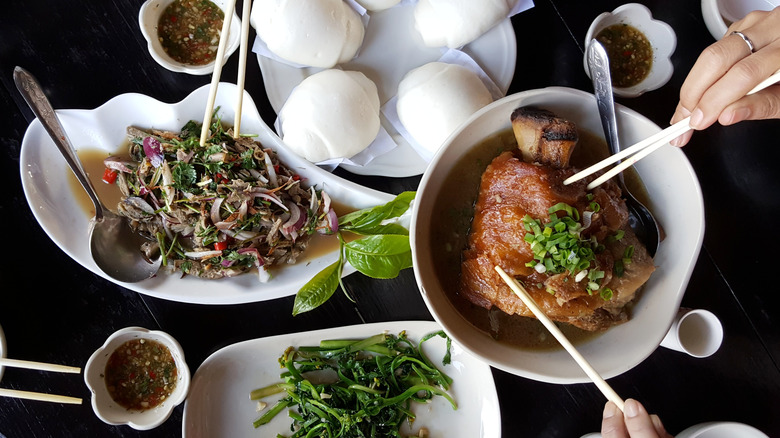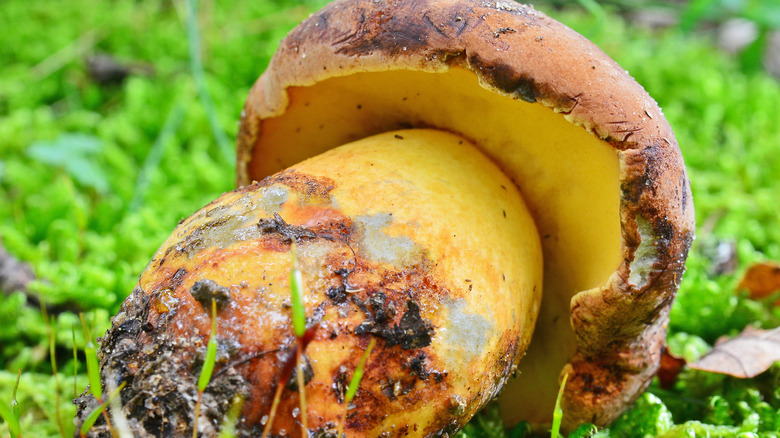Jian Shou Qing, The Mushroom Delicacy In Yunann Cuisine
As a part of U.S. Treasury Secretary Janet Yellen's efforts to repair the nation's relationship with China, Yellen boarded the long flight from DC to Beijing to meet with China's new economic policy leaders in July 2023. Despite presenting no new policies, she did indeed spend a total of 10 hours in discussions with China's economic policymakers (per the New York Times). She also assured them that the U.S. seeks to diversify its supply chains, not decouple from its economic relationship with China. However, one of the most surprising results of her four-day visit to the capital city had nothing to do with politics at all — rather, it involved a specific type of mushroom that may or may not be hallucinogenic.
Shortly after arriving in Beijing, Yellen and her team sat down at a restaurant called Yi Zuo Yi Wang, which specializes in Yunnan food — a regional cuisine from the southwestern area of China that borders Vietnam, Laos, and Myanmar. Yellen and her delegation were quickly recognized among the crowd. One local food blogger, Pan Pan Mao, who was also in attendance, made sure to sneak a peak at the delegation's plates as they walked by the table. A post on the blogger's Weibo account recounted the dishes they spotted: grilled perch with herbs, cold rice noodles, stir-fried pickled Yunnan wild greens with potato slices, and sure enough, a plate of jian shou qing — the mysterious species of Yunnan wild mushrooms that have made the meal a highly publicized affair.
What is jian shou qing?
It's no secret that Chinese food has been a major topic of discussion since 2020, when speculations about COVID-19's origins were misattributed to the consumption of infected bats in southern China — although a 2022 study published in the journal Science did conclude that the pandemic originated from wildlife sold at the Huanan Seafood Wholesale Market. Needless to say, premature reporting from media outlets fueled nationwide bigotry. In the industry-altering years that followed the pandemic, Chinese restaurants ultimately suffered the most. Whether intentional or not, Janet Yellen's public embracing of local Chinese cuisine set a positive example. But it was her choice of having jian shou qing — four orders of it, to be exact — that took on a story of its own.
Jian shou qing is a term for a family of mushrooms, but in Yunnan, it's recognized as a specific type of mushroom scientifically known as Lanmaoa asiatica. The mushrooms are medium to large in size, with red skin and yellow gills underneath their caps; they look a lot like porcini mushrooms. In fact, they're often confused for them — which can have unforeseen results, considering if the lanmaoa mushroom isn't cooked fully, it can have hallucinogenic effects, as Dr. Peter Mortimer of the Kunming Institute of Botany told CNN. You can imagine the shock of the news that a United States national secretary consumed potentially hallucinogenic mushrooms while on business, and some media outlets ran with that headline. Nevertheless, the restaurant staff assured reporters that all of the food served at Yi Zuo Yi Wang is prepared correctly.
How jian shou qing is prepared
Jian shou qing is widely considered a delicacy among Yunnan locals — and if anyone knows anything about mushrooms, it's the people of Yunnan. The region is home to over 900 different mushroom species. The geographic location of the province suits the people's love for fungi, not just by supplying the goods but also by supporting a diverse mushroom population — and therefore, diverse flavors to build off of them. It's why Yunnan cuisine, and Yunnan restaurants, have soared in popularity all over China. But with so many mushrooms available in Yunnan, why would someone choose to consume a potentially toxic one?
As it turns out, despite the risk, jian shou qing has a sublime flavor — one that many people of Yunnan consider to be the best of all. When cooked, they release an umami aroma comparable to bacon; as they continue to cook down, that scent gradually fades into the distinct smell of walnuts. The taste has similarly been described as bursting with nutty and umami flavors that are intended to be savored. While they make a great accompaniment to other local dishes like hot pot or rice noodles, in order to get the most out of their flavor, they're best enjoyed simply. A quick — but not too quick — stir fry is typical and will usually suffice to cook them properly.


